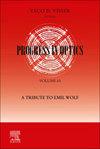Tuning of Reciprocal Plasmonic Metasurface Resonances by Ultra-Thin Conformal Coatings
3区 物理与天体物理
Q1 Materials Science
引用次数: 3
Abstract
Metamaterials, in the form of perfect absorbers, have recently received attention for sensing and light-harvesting applications. The fabrication of such metamaterials involves several process steps and can often lead to nonidealities, which limit the performance of the metamaterial. A novel reciprocal plasmonic metasurface geometry composed of two plasmonic metasurfaces separated by a dielectric spacer was developed and investigated here. This geometry avoids many common fabrication-induced nonidealities by design and is synthesized by a combination of two-photon polymerization and electron-beam-based metallization. Infrared reflection measurements revealed that the reciprocal plasmonic metasurface is very sensitive to ultra-thin, conformal dielectric coatings. This is shown here by using Al2O3 grown by atomic layer deposition. It was observed experimentally that incremental conformal coatings of amorphous Al2O3 result in a spectral red shift of the absorption band of the reciprocal plasmonic metasurface. The experimental observations were corroborated by finite element model calculations, which also demonstrated a strong sensitivity of the reciprocal plasmonic metasurface geometry to conformal dielectric coatings. These coatings therefore offer the possibility for post-fabrication tuning of the reciprocal plasmonic metasurface resonances, thus rendering this novel geometry as an ideal candidate for narrow-band absorbers, which allow for cost-effective fabrication and tuning.超薄共形涂层对互易等离子体超表面共振的调谐
超材料是一种完美的吸收材料,近年来在传感和光收集方面的应用受到了人们的关注。这种超材料的制造涉及几个工艺步骤,并且经常会导致非理想性,这限制了超材料的性能。本文提出并研究了一种由介电间隔分隔的两个等离子体元表面组成的新型互易等离子体元表面几何结构。这种几何结构通过设计避免了许多常见的制造引起的非理想性,并通过双光子聚合和电子束金属化的结合来合成。红外反射测量表明,互易等离子体超表面对超薄共形介质涂层非常敏感。这是用原子层沉积生长的Al2O3来证明的。实验观察到,增加非晶Al2O3的保形涂层会导致互易等离子体超表面吸收带的光谱红移。有限元模型计算证实了实验结果,也证明了互易等离子体超表面几何形状对保形介质涂层具有很强的敏感性。因此,这些涂层提供了制作后调谐互反等离子体超表面共振的可能性,从而使这种新颖的几何形状成为窄带吸收器的理想候选者,从而允许具有成本效益的制作和调谐。
本文章由计算机程序翻译,如有差异,请以英文原文为准。
求助全文
约1分钟内获得全文
求助全文

 求助内容:
求助内容: 应助结果提醒方式:
应助结果提醒方式:


